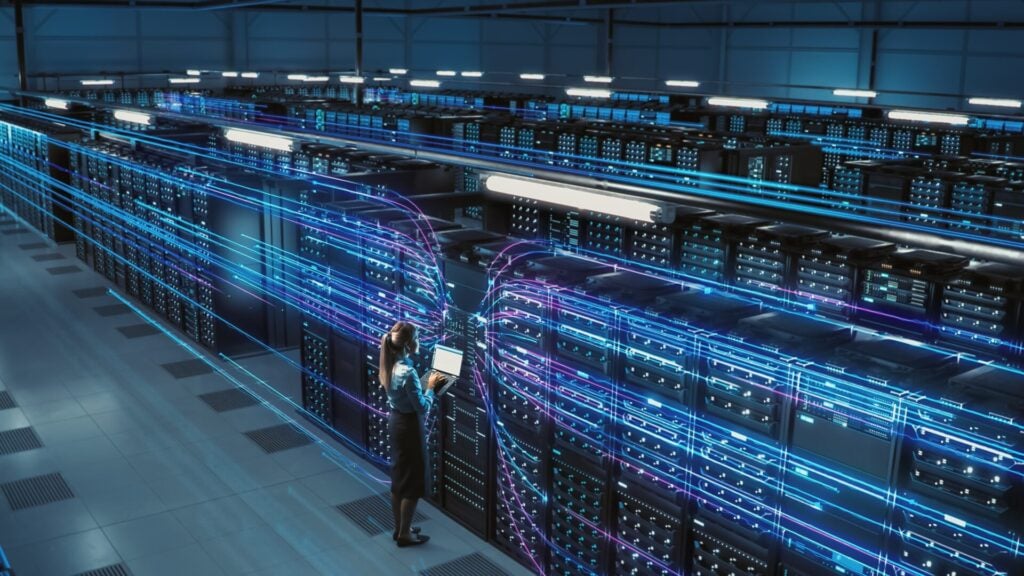We treat the cloud like it’s weightless, a place where emails, photos, playlists, and now even our AI-generated essays float neatly in the digital ether. But there’s nothing light about it.
Every time you ask ChatGPT for a dinner recipe, stream a show on Netflix, or prompt Midjourney to design your dream kitchen, you’re tapping into a global network of energy-guzzling data centres – buildings that demand massive amounts of electricity and water to keep running. And as AI rapidly becomes embedded in everything from search engines to spreadsheets, the environmental cost of ‘the cloud’ is ballooning.
The Cost of (AI) Convenience
Why is the cloud so essential? Over 50 per cent of businesses worldwide run their operations in the Cloud, with another 40 per cent expected to adopt multi-Cloud technology by 2030. It offers the convenience we demand as consumers, easy scalability, and efficiency. While streaming videos and backing up photos once dominated cloud usage, the biggest growth driver today is artificial intelligence. From real-time voice assistants to personalised shopping suggestions, every AI interaction relies on complex models hosted in the cloud. Unlike traditional data, these models require far more energy – both to train and to run – and they’re being accessed by millions daily.
But as the cloud expands, so does its environmental footprint.

Behind the scenes of every streamed movie, voice-command lighting system, or AI generated essay lies a network of energy-hungry data centres. Giant facilities house thousands of servers that require immense amounts of electricity to operate and stay cool. According to the International Energy Agency (IEA), global data centres account for about 1-1.5 per cent of electricity use worldwide. Cooling alone can consume up to 40 per cent of a data centre’s energy.
Since the launch of ChatGPT in late 2022, an estimated 400 million people now use it weekly. And that’s a problem for our planet. A single Google search emits around 0.2 grams of CO₂ while a single AI-powered query? As much as ten times more. That’s because AI models rely on constant inference – crunching enormous datasets to give you instant, tailored responses. Multiply that by billions of daily AI queries, and it’s easy to see why data centre emissions are rising fast.
In 2023 alone, Microsoft spent over $10 billion expanding its data centre footprint largely to support its AI ambitions. Amazon, Meta, and Google aren’t far behind. AI isn’t just driving innovation; it’s driving a land rush for servers, energy, and water often in already resource-stressed regions.

Air-cooling technology isn’t strong enough to handle the temperatures data centres can reach. Due to this, water, already a scarce resource for over a billion people on Earth, is consumed in large quantities. It is mostly used onsite for cooling including pipes, pumps, cooling towers, condensers, facility maintenance and humidification systems. Offsite, they also indirectly use water reserves through the power plants that run them. Google’s data centre in The Dalles, Oregon, was using more than one quarter of the city’s total water consumption by 2023.
Then we come to the carbon emissions linked to cloud services, which are equally concerning. Data centres contribute approximately 330 million metric tons of CO2 annually, which is the equivalent released by powering 40 million homes a year. To put it another way, that figure would be released by raising and processing 66 billion pounds of beef, so giving up meat while using Copilot to prepare your shopping list is counterproductive.
Seeking solutions
At least some of the major players are aware of the impact and are working to change things for the better. Cloud providers like Amazon Web Services (AWS), Google Cloud, and Microsoft Azure are taking steps toward sustainability. Google, for instance, has committed to operating on 100 per cent renewable energy and achieving carbon neutrality. Microsoft has invested in AI-driven resource management to optimise energy use.
In Singapore, Keppel Data Centres have launched a floating data centre, FDCP, which harnesses sea water for cooling, thus increasing its cooling efficiency by up to 80 per cent. This also skips the need for potable or industrial water in cooling towers, which is a big win for sustainability. And by looking to integrate LNG, and possibly hydrogen, for onsite energy, the setup is designed to be as efficient and future-focused as possible.
Governments are also stepping up. In 2023, Germany enacted the Energy Efficiency Act, which has specific regulations relating to data centres, requiring any establishments to reuse up to 20 per cent of their waste heat. It may not seem revolutionary, but it’s a start. The EU, which coordinates the cooperation of its 27 member states, has introduced the Corporate Sustainability Reporting Directive (CSRD) which requires companies to share how they’re approaching sustainability. That includes outlining their policies, showing progress, and setting clear goals to cut greenhouse gas emissions.

Don’t forget that our influence as consumers can also have an impact. Raising awareness and demanding that companies prioritise sustainability is crucial. In Uruguay, campaigners have been pushing back against Google’s planned data centre near Montevideo. Citing concerns over water usage and environmental impact, they managed to get the project scaled down from two data centres to one, with its capacity cut by two-thirds. The centre will also switch to air-cooling.
What can we do?
One of the simplest ways we can manage our digital carbon footprint is by being more mindful of our everyday online habits. Start by unsubscribing from emails you never read, deleting unnecessary files, and clearing out duplicate photos on your phone. Switch off autoplay on streaming platforms to reduce data consumption, and consider using a search engine like Ecosia, which plants trees with every search. Even fully powering down devices at night instead of leaving them on standby, can conserve energy, improve your sleep, and shave a little off your electricity bill.
You can also make small but impactful choices like lowering the video quality on your streaming apps and switching off your camera during video calls when it’s not essential. (Consider this your permission to skip the next Zoom meeting – it’s for the planet). And before you reach for an AI tool out of habit, ask yourself if you really need it because behind every instant response is a server working overtime.
ight now, the cloud is casting a rather murky shadow over our digital future. But building a more sustainable, less extractive cloud – especially one increasingly powered by AI – is a shared responsibility. With thoughtful innovation and more conscious choices from tech giants, governments, and users alike, we can help ensure that the cloud reveals more sunshine than toxic rain.









